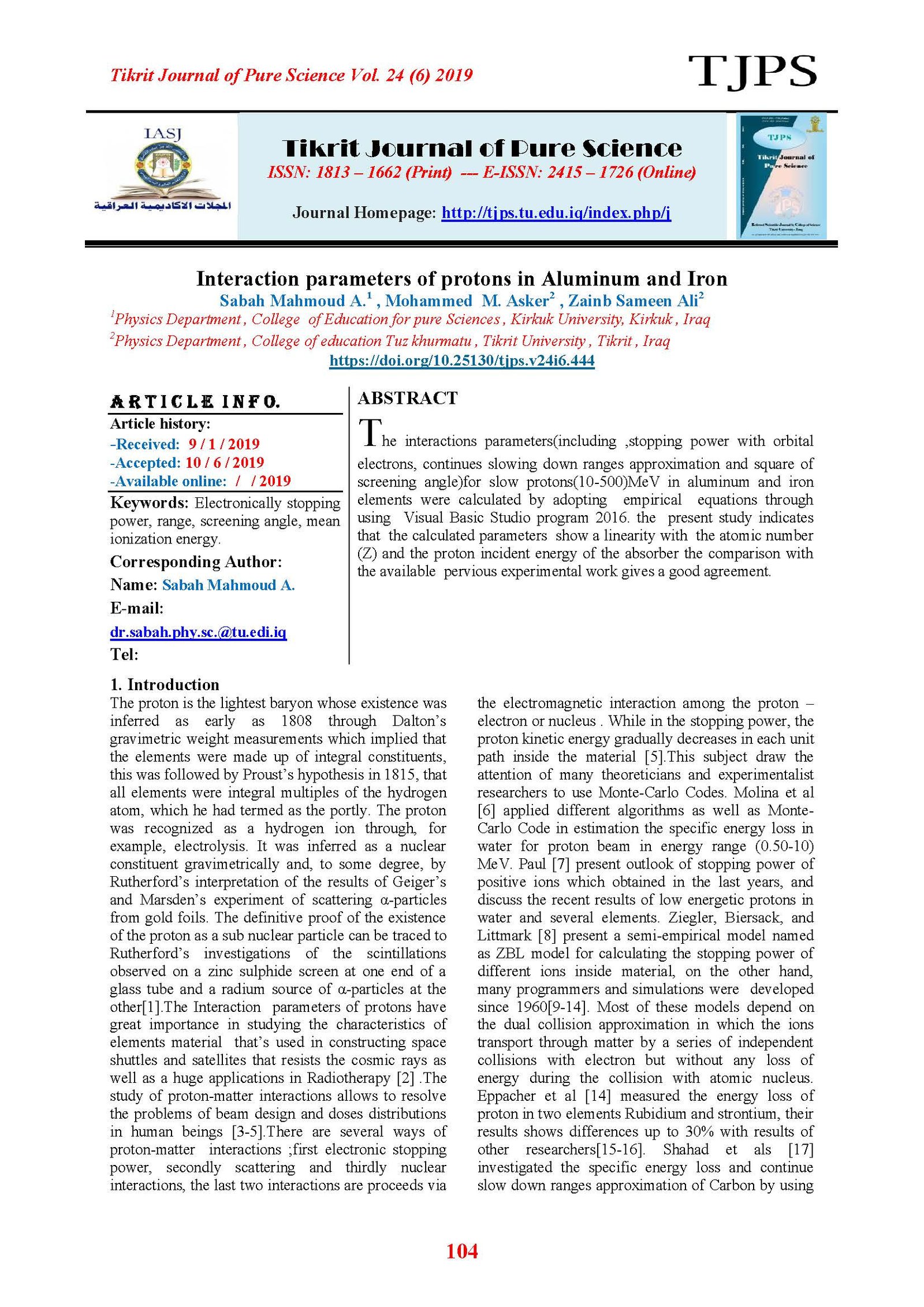Interaction parameters of protons in Aluminum and Iron
Main Article Content
Abstract
The interactions parameters(including ,stopping power with orbital electrons, continues slowing down ranges approximation and square of screening angle)for slow protons(10-500)MeV in aluminum and iron elements were calculated by adopting empirical equations through using Visual Basic Studio program 2016. the present study indicates that the calculated parameters show a linearity with the atomic number (Z) and the proton incident energy of the absorber the comparison with the available pervious experimental work gives a good agreement.
Article Details

This work is licensed under a Creative Commons Attribution 4.0 International License.
Tikrit Journal of Pure Science is licensed under the Creative Commons Attribution 4.0 International License, which allows users to copy, create extracts, abstracts, and new works from the article, alter and revise the article, and make commercial use of the article (including reuse and/or resale of the article by commercial entities), provided the user gives appropriate credit (with a link to the formal publication through the relevant DOI), provides a link to the license, indicates if changes were made, and the licensor is not represented as endorsing the use made of the work. The authors hold the copyright for their published work on the Tikrit J. Pure Sci. website, while Tikrit J. Pure Sci. is responsible for appreciate citation of their work, which is released under CC-BY-4.0, enabling the unrestricted use, distribution, and reproduction of an article in any medium, provided that the original work is properly cited.
References
[1]Brian, J.M. (2014). Medical Radiation dosimetry –Theory of charged particle collision energy loss 1st.London: Springer Verlag: 25-30pp.
[2] Todor, S. (2010). High energy cosmic rays 2nded. Springer-Verlag, London: 210pp.
[3] Chaubey, A. K. and Gupta, H. V. (1977).New empirical relations for stopping power and range of charged particles. Revue de PHYSIQUE Appliquee, 12(1): 321.
[4] Paganetti, H.( 2012 ). Proton Therapy physics .Taylor and Francis Group: 19-61pp.
[5] Marouane, A.; Ouaskit, S. and Inchaouh, J. (2011).Precise determination of the Bragg peak position of proton beams in liquid water. Radiation Measurements. 15(3):988–992
[6] Denton, C.D.; Molina, R.G.; Abril, I. and Arista, N.R. (1998). Contribution of nuclear scattering to the energy loss distribution of protons in carbon foils.
Nuclear Instruments Methods Physics Research B (135): 45–49.
[7] Paul, H. (2010).Recent results in stopping power for positive ions and some critical comments .Nuclear Instruments Methods Physics Research. B (268): 3421–3425.
[8] Ziegler, J.F.; Biersack, J.P. and Littmark, U.B. (1985). Range distributions for energetic Ions in all elements. In: Ziegler J.F (ed) Pergamon Press, New York: 231-235
[9] Abril, I.; Molina, R.G.; Denton, C.D.; Perez, F.G., and Arista, N.R. (1998). Dielectric description of wakes and stopping powers in solids. Physical Reviews, 58(1):357
[10] Heredia, A.S.; Garcia, M.R.(2002).Projectile Polarization Effects in the Energy Loss of Swift Ions in Solids. Nuclear Instruments Methods Physics Research B (193):15−19
[11] Date, H.; Sutherl and K.; Hasegawa, H. and Shimozuma, M. (2007). Ionization and excitation collision processes of electrons in liquid water. Nuclear Instruments Methods Physics Research
B (265): 515–520
[12] Date, H., et al. (2005). Electron Collision Processes in the Bragg Peak Region of Proton in Water. The 4th Japan-Korea Joint Meeting on Medical Physics and the 5th Asia-Vol.25 Supplement No.3-1, 340-343
[13] ICRU49.(1993).Stopping Powers and Ranges for Protons and Alpha Particles. International Commission on Radiation Units and Measurements. 324pp.
[14] Eppacher, C. et al.(1994). Stopping power of lithium for hydrogen projectiles .Nuclear Instruments and Methods. 3(4):639-642
[15] Janni, J.F.(1982).Proton Range-Energy Tables and 1KeV - 10GeV: Energy Loss and Range and Path Length and Time-of-Flight and Straggling and Multiple Scattering and Nuclear Interaction Probability. Part I: For 63 compounds. Atomic Data and Nuclear Data Tables 27.143-349pp.
[16]Mustafa, C.T; Onder, K. and Hassan G. (2006). Calculation of the stopping power for intermediate energy positrons. Chinese Journal of physics, 44(4): 290-296.
[17] Shahad, A. S. and Sabah M. A.(2015). Evaluation the Collisional Stopping power and Continuous Slow down Approximation ranges for protons in Carbon. Journal of Sulmania University, 17( 4 ):179-186
[18] Mladjenovic, M. (1973). Radioisotopes and Radiation Physics –An Introduction. London: Academic press: 77-83pp.
[19] Shultis, J.K. and Richars, E.F. (2002). Fundamentals of Nuclear Science and Engineering. , Marcel Dekker: 196-198 pp.
